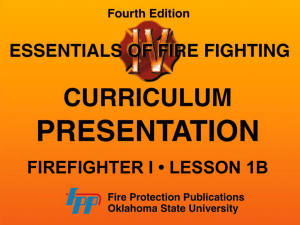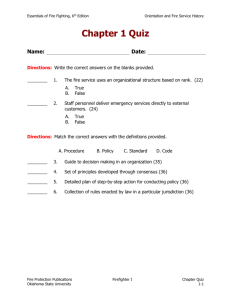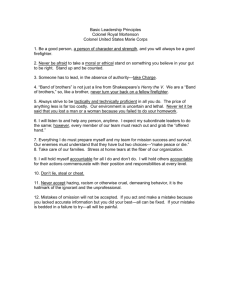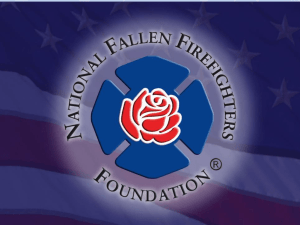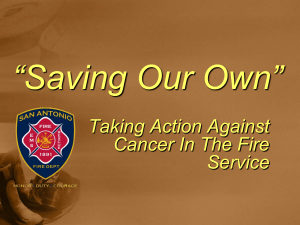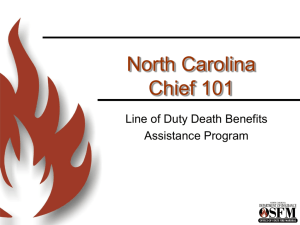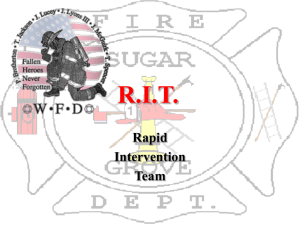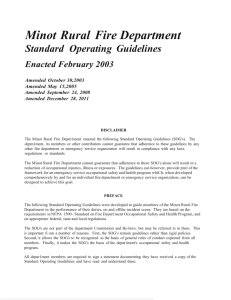PowerPoint: 16 Firefighter Life Safety Initiatives
advertisement
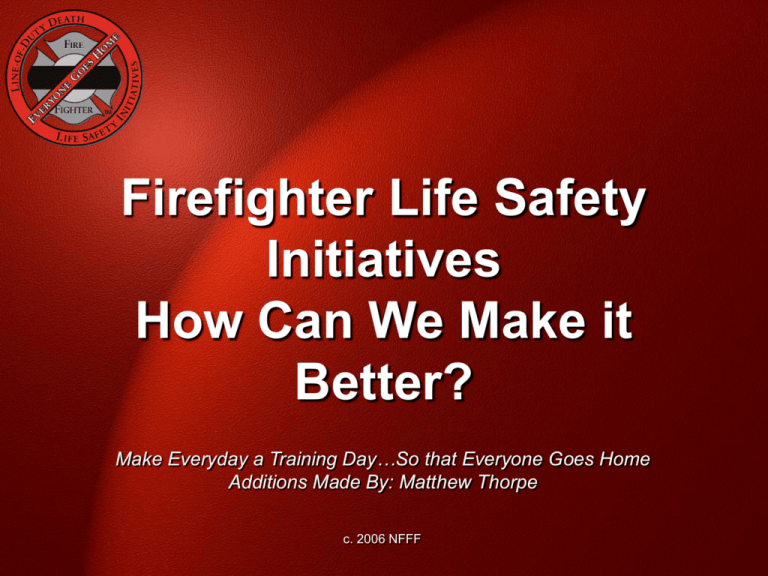
Firefighter Life Safety Initiatives How Can We Make it Better? Make Everyday a Training Day…So that Everyone Goes Home Additions Made By: Matthew Thorpe c. 2006 NFFF In April of 2004, fire service leaders from across the United States gathered in Tampa, Florida. At this summit meeting these leaders began to design a new fire service culture. This new culture is built on the 16 Firefighter Life Safety Initiatives so that Everyone Goes Home. Life Safety Initiatives Program Goal Since 1984, 3175 firefighters have died in the Line of Duty—many thousands more have been injured. We accept 100 deaths every year as normal Ten Years 50% Reduction 2004 Five Years 25% Reduction 2009 2014 The Initiatives Address Six Focus Areas • Prevention Structural Firefighting • • • • • Wildland Operation Health, Wellness & Fitness Vehicles Training The initiatives Address Six Root Causes of LODDs • Ineffective Policies & Procedures • Ineffective Decision Making • Lack of Preparedness • Ineffective Leadership • Lack of Personal Responsibility (inappropriate behavior) • Extraordinary & unpredictable circumstances Initiative # 1 Define and advocate the need for a cultural change within the fire service relating to safety; incorporating leadership, management, supervision, accountability and personal responsibility. What Initiative #1 Means Cultural change has to begin with informal leaders, managers, supervisors. From top to bottom: the culture of the fire service must change. You can change your behavior TODAY. Be part of the “NEW” Fire Service Safety Culture Examine your attitudes & behaviors regarding safety Realize that change is not a threat to the organization Embrace Health & Wellness programs & practice them Lead by your own example & make the difference—be an agent of change Initiative # 2 Enhance the personal and organizational accountability for health and safety throughout the fire service. What Initiative #2 Means Each fire service organization must promote safe practices; each individual must have the tools to be safe and adhere to safe practices at ALL TIMES. Follow SOPs at all times Train / Learn / Teach everyday Utilize the Incident Command System Adhere to Vehicle Inspection Schedules Schedule and stick to equipment checks “Strap in and Stay In” Don’t take the environment for granted Initiative # 3 Focus greater attention on the integration of risk management with incident management at all levels, including strategic, tactical, and planning responsibilities. What Initiative #3 Means Learn the concept of “Risk Management”; Ensure everyone understands the difference between an acceptable risk and an unacceptable risk. Develop and implement a system to pre-identify unacceptable risks. Risk a lot to save a lot; risk a little to save a little Review every call Develop Command Teams Follow SOPs…Follow SOPs Know the function and status of every firefighter on the incident scene…Everyone must be accounted for at all times Initiative # 4 All firefighters must be empowered to stop unsafe practices. What Initiative #4 Means Firefighters must be allowed to identify and report unsafe practices. They must be able to stop activities that present imminent harm to themselves or others, without fear of penalty or reprisal. Be aware of safe practices and look for unsafe ones Take the initiative to develop and implement procedures to enable and empower firefighters to stop unsafe conditions in training, on the fire ground and during routine operations Never question the integrity of those who speak out for safe fire ground operations Initiative # 5 Develop and implement national standards for training, qualifications, and certification (including regular re-certification) that are equally applicable to all firefighters based on the duties they are expected to perform. What Initiative #5 Means Fire service departments are recognizing national certification standards as a way to measure the competency of their members. National standards encourage departments to operate at higher levels of effectiveness. Seek state and national certifications at all levels of your fire department employment Support efforts toward mandatory re-certification or refresher training; refreshing teaches new methods and improves skills which are used infrequently Initiative # 6 Develop and implement national medical and physical fitness standards that are equally applicable to all firefighters, based on the duties they are expected to perform. What Initiative #6 Means In this profession, health and wellness are non-negotiable. Departments should establish and enforce SOPs which support wellness. Individuals must embrace wellness as a strategy for successful fire service careers or seek employment elsewhere. Adopt a heart-healthy lifestyle, including making healthful food choices and regular exercise Don’t smoke / Don’t do drugs Follow all health and wellness SOPs Be a Good Example Understand the impact your death would have on your family, co-workers and community Initiative # 7 Create a national research agenda and data collection system that relates to the initiatives. What Initiative #7 Means We won’t know if we are living the initiatives if we do not collect data. Data analysis is the key to making any course corrections regarding the Life Safety Initiatives. It will also provide important corollary data. Encourage your department to participate in national data recovery systems such as NFIRS Support data gathering at the local level Be vocal with local politicians about where your tax money is spent—urge them to support our national agenda for firefighter safety Initiative # 8 Utilize available technology wherever it can help produce higher levels of health and safety What Initiative #8 Means It is irresponsible not to use technology when it can improve safety outcomes. Technological solutions should be a leverage and a tool for improving fire ground safety. Attend conferences to keep abreast of new technologies and take this knowledge back to your department Encourage your department to employ Command and Rescue vehicles on scene which are equipped with technological advance systems that can be integrated into the command system Become the technology geek of your department Initiative # 9 Thoroughly investigate all firefighter fatalities, injuries, and near misses. What Initiative #9 Means Even if your organization is uncomfortable with sharing information about a fatality, injury, or near-miss incident, it is a moral obligation to do so. Knowing what happened can prevent it from happening again. Implement investigations without delay—learning can begin immediately Be familiar with NIOSH, FEMA, USFA, CDC, NFPA reports. They can be studied to increase safety Encourage the collection of “near-miss” data. Nearmiss incidents provide excellent learning / training tools Look for the “Fatal Chain of Errors” Initiative # 10 Grant programs should support the implementation of safe practices and / or mandate safe practices as an eligibility requirement. What Initiative #10 Means There is grant money available for you to begin implementing the initiatives. Grants should however, be tied to increasing safety measures. No safe practices / no grant. If you ask for a grant to improve health and wellness for example, recommendations should be made and implemented as a condition of future grants. Take time to learn how to write grants professionally— beginning with the identification of granting sources. Initiative # 11 National standards for emergency response policies and procedures should be developed and championed. What Initiative #11 Means National Standards for emergency response policies and procedures should be developed. At the local level, departments may have to increase response times to “arrive alive.” Help to adopt safe driving rules and enforce them. Secure loose objects in cabs and on vehicles. Respond to emergencies using emergency response SOPs; no red lights and sirens to routine calls. Make sure all vehicles meet current safety standards. MOST IMPORTANT: MANDATE SEAT BELT USE! Initiative # 12 National protocols for response to violent incidents (including terrorism) should be developed and championed. Ky. Firefighter Killed, Second Wounded in Shooting at Scene of Domestic 'Worst Nightmare': Domestic Dispute Call Turns to Tragedy Memphis: Firefighting Presents More Dangers Than Just Fire Six Firefighters Shot, Injured in Indiana Violence All Remain Hospitalized, One Seriously What Initiative #12 Means Fire and EMS workers deserve to have policies which will reduce their exposure to all threats of violence. Promote policies to “stage” violent incident responses, removing the pressure to react immediately. SOPs should include “GO” and “NoGO” criteria. Learn all you can about responding to terrorist incidents, regardless of your department’s size or proximity to predicted targets. Initiative # 13 Firefighters and their families must have access to counseling and psychological support What Initiative #13 Means Firefighting is a high-risk occupation which, from time to time, can put the employee and his or her family under extreme stress. They deserve access to mental health care. If you are feeling stress (depression / anxiety or physical symptoms) seek help from physicians, EAP counselors, and religious or other sources. Don’t “tough it out”; this could lead to bad results for you and your family. Stress-awareness should be part of firefighter training at all levels. Help a buddy you see struggling with stress-related problems. Initiative # 14 Public education must receive more resources and be championed as a critical fire and life safety program What Initiative #14 Means Public Education is a responsibility of all fire service personnel. It should not be reserved for one week in October. Increased civilian awareness will decrease firefighter risks. Make communicating the fire prevention message to the community a priority. Utilize USFA resources and materials—they are free and excellent. Become an ambassador for community safety in your church, children's’ schools, volunteer groups, etc. Become an advocate for code adoption & enforcement . Initiative # 15 Advocacy must be strengthened for the enforcement of codes and the installation of home fire sprinklers What Initiative #15 Means The widespread use of residential sprinklers will improve outcomes for civilians and decrease firefighter injuries and LODDs. Ensure all firefighters understand how sprinkler systems operate and the value they bring to reducing Line of Duty Deaths. Actively advocate for residential sprinkler laws and widespread adoption. If you build a home, consider the installation of a sprinkler system—lead by example. Initiative # 16 Safety must be a primary consideration in the design of apparatus and equipment. What Initiative #16 Means Encourage your department to make “safety” the highest priority in equipment and apparatus purchases — as high as design and price. Form an apparatus committee and help set your department’s policies on equipment and apparatus purchases. Read professional journals and attend conferences where new innovations in apparatus and equipment are demonstrated. Learn NFPA standard 1901 regarding apparatus safety standards. Self-Evaluation Summary • Is Your Department on the path to a Line of Duty Death ? • Do you know what the path looks like ? Does it Look Like this? • • • • • • • • • • More Accidents Criminal Charges Incarceration Civilian casualty Firefighter casualties Older & Heavier Stiff versus Flexible High Cholesterol versus Low Insulin versus Non Insulin Experience Exchange versus Early Death IF YOUR DEPARTMENT IS ON THE ROAD TO A LINE OF DUTY DEATH YOU CAN BEGIN TODAY TO CHANGE THE ROAD YOU’RE ON: Watch the videos in the Firefighter Life Safety Resource Kit Conduct an organizational assessment and implement changes Encourage and reward positive changes toward safety Make a Commitment TODAY… Become an ADVOCATE for the 16 FIREFIGHTER LIFE SAFETY INITIATIVES For more information on the Courage To Be Safe…So Everyone Goes Home program www.everyonegoeshome.com


